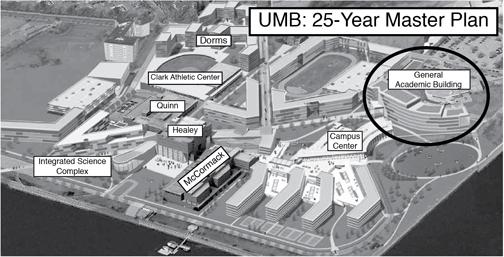
What does the future hold? No more Wheatley, no more Science Building, a bunch of new academic buildings, and for the first time, dorms.
Two years and $100 million from now, a new addition to campus will open its doors. The General Academic Building (GAB No. 1) will replace the North Lot, where construction is set to begin in mid 2012. One of the first stages of the 25-year Master Plan, GAB No. 1 will function primarily as a teaching space.
The building, which is funded by the UMass Building Authority, will have 171 thousand square feet and feature 27 general-purpose classrooms, art studios, labs, a theater, recital hall, dance studio, as well as administrative and faculty offices.
Assistant Chancellor Terry Mortimer explained the purpose of the new building and the Master Plan as a whole.
“People who cannot afford an education at Harvard shouldn’t have to settle for a second-class education. Providing high quality education means having up-to-date facilities,” Mortimer said.
GAB No. 1 will house the art and the performing arts departments as well as new chemistry labs. It will also have its own café with a seating area, and lounge areas for “interaction and study.”
During its construction, the building is expected to put further strain on the university’s already crowded parking situation.
Holly Sutherland, manager of Master Plan and construction communications, described how parking issues would be resolved.
“Transportation focus groups will help administrators plan for reduced parking space,” she said. “They will be reaching out to students in established groups like the USG to get student input as to how to make it work best.”
Sutherland also explained that the university is seeking a silver class Leadership and Energy Environmental Design (LEED) certificate. LEED is an internationally recognized certification system developed by the U.S. Green Building Council, which provides a standardized framework for green building design and construction.
Of the 27 general-purpose classrooms GAB No. 1 is expected to hold, 18 will have a capacity of 50 students, while eight of the classrooms will have a capacity of 50-plus students. A 500-seat lecture hall will serve as a replacement to the Lypke Auditorium, which will eventually be demolished along with the rest of the Science Building.
Not everyone in the UMB community is excited about the new building.
Professor Gary Zabel, senior lecturer of philosophy, raised concerns about the way students will be taught in the larger classrooms of new building.
“Face-to-face communication between students and professors is a really important part of the education system at UMB,” Zabel said. “Currently our classroom sizes are between 30 and 40 students. This means the professor can notice if a student starts to fall behind. In these larger classrooms students will not have the same personal relationship with the instructors.”
Addressing these concerns, Assistant Chancellor Mortimer said that the classrooms in GAB No. 1 will not dramatically change student-professor interactions at UMB.
“You’re not getting this massive influx of big classrooms that will dramatically change the way classes are taught. There will always be a terrific mix of small classrooms and large lectures halls,” Mortimer said.
The architecture firm hired to design the new building is Wilson Architects, a Boston-based firm that specializes in design of science research and teaching facilities for higher education. The company in charge of construction management is the Gilbane Building Company, which offers construction and program management. All new UMB projects have to conform to the regulations put forth by the Project Labor Agreement, which requires that construction be performed by union laborers.
For more information about GAB No. 1 and the rest of the 25-year Master Plan visit http://www.umb.edu/the_university/masterplan.
What are your thoughts about the plan? Let us know at [email protected].




















































